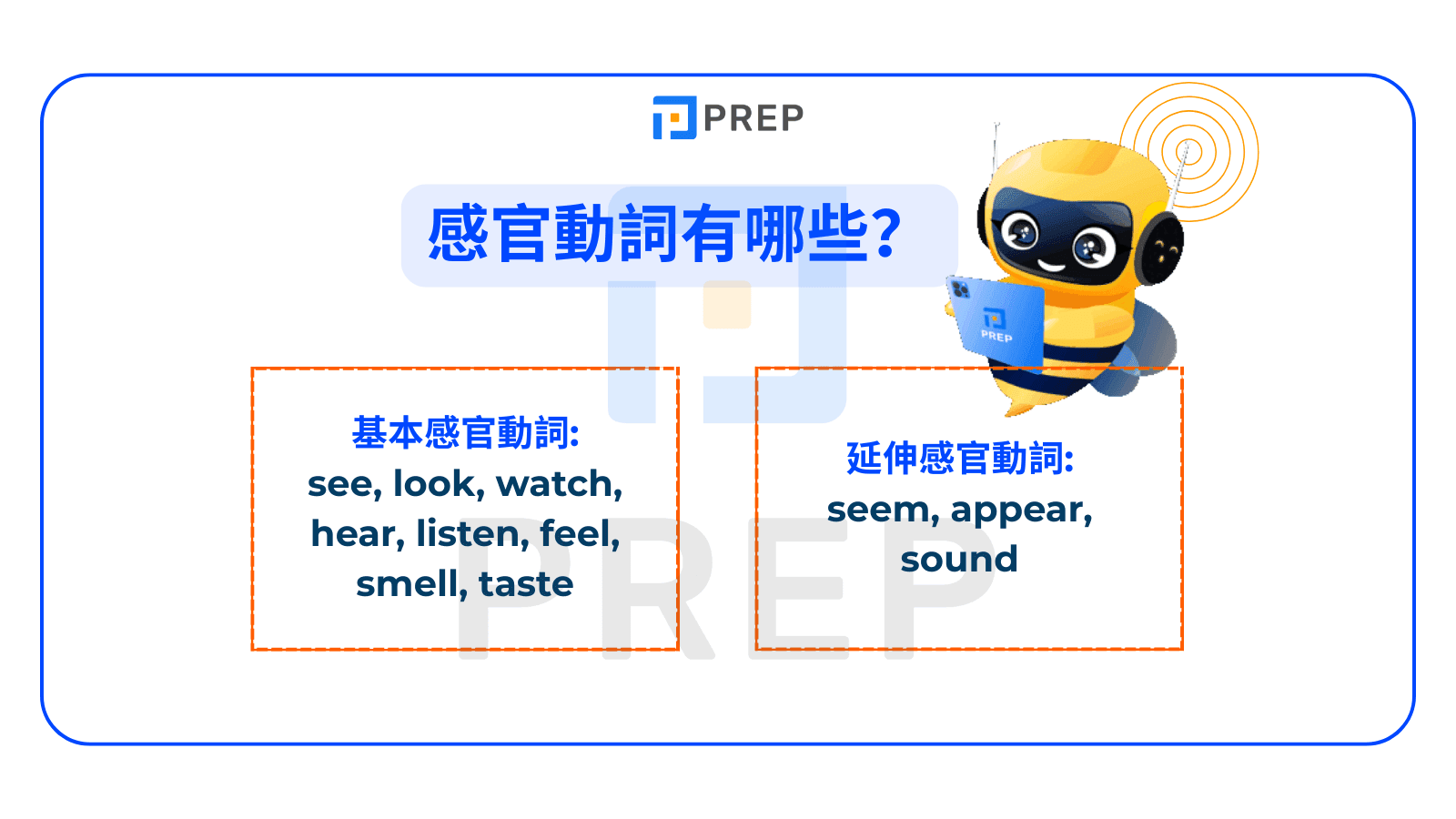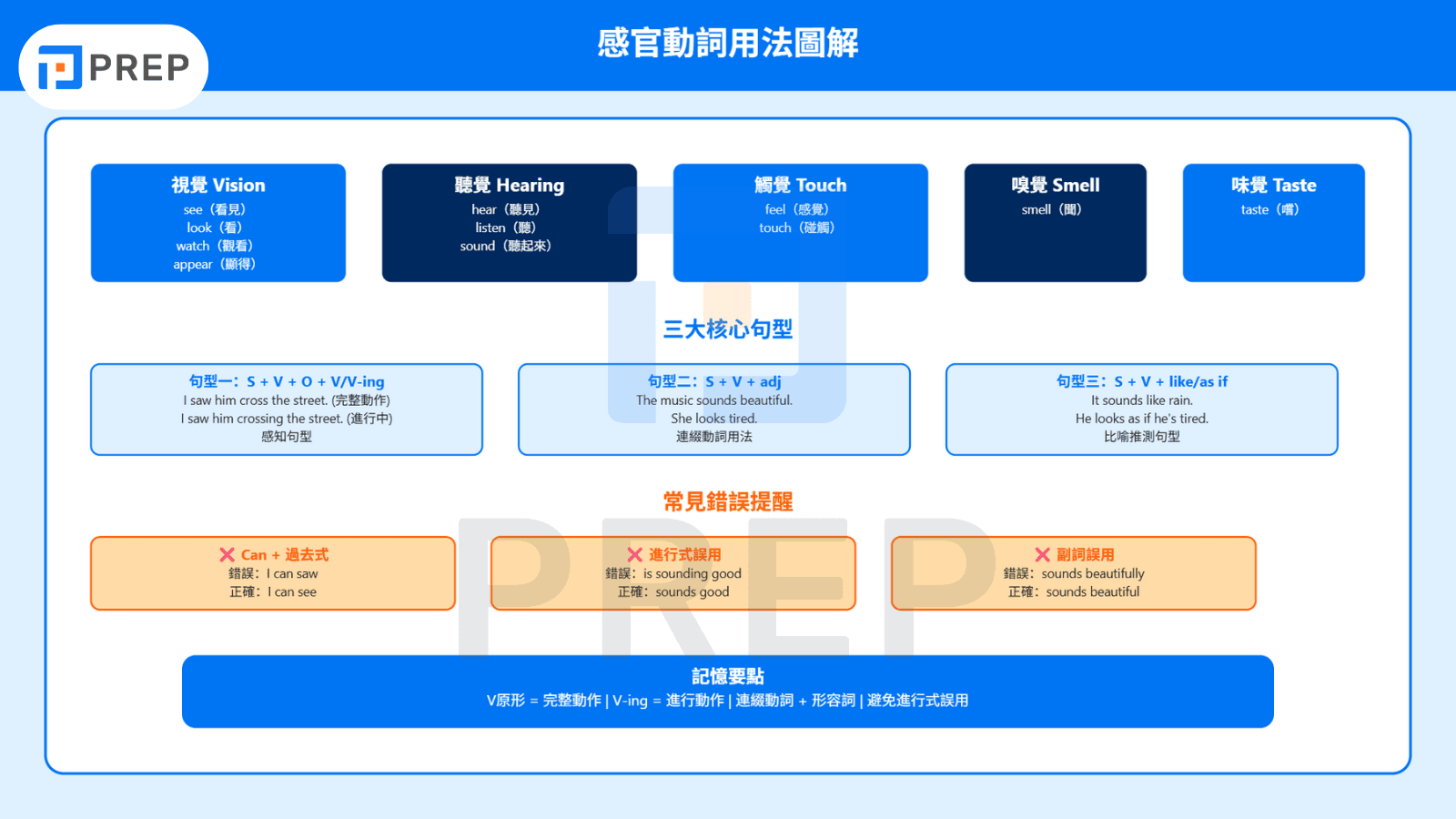感官動詞終極指南:一次搞懂 see, hear, feel 所有用法 (V/Ving, 被動語態, 與使役動詞比較)
在PREP的英語教學經驗中,我們發現超過80%的學習者都曾被「I saw him cross」與「I saw him crossing」的差異困擾過,這正是感官動詞學習的核心難點。感官動詞是英語動詞系統中的重要分支,掌握感官動詞用法是提升英文表達精準度的關鍵。
感官動詞英文稱為Sense Verbs,涵蓋see、hear、feel、smell、taste等核心動詞,以及look、sound、appear等延伸用法。這些動詞不僅描述五官感知,更影響句型結構和語意表達。許多學習者在感官動詞後面加什麼、如何區分動態與靜態用法、何時使用原形動詞或現在分詞等問題上經常出錯。更複雜的是,感官動詞有哪些、各自的特殊文法規則、與使役動詞的差異比較,都需要系統性學習才能完全掌握。
本文將透過三大核心句型、實用比較表格、常見錯誤分析和豐富例句,幫你建立完整的感官動詞知識體系,從基礎概念到進階應用一次搞定。現在讓我們從感官動詞的基本定義開始深入探討。

I. 什麼是感官動詞 (Sense Verbs)?
感官動詞是英語動詞中用來描述五官感知的特殊動詞類別,感官動詞英文稱為 Sense Verbs 或 Perception Verbs。這類動詞分為兩大類:「感知動詞」(如 see、hear)和「狀態動詞」(如 look、sound)。
感知動詞範例:
-
I saw my neighbor walking his golden retriever in the park this morning.(我今天早上看見鄰居在公園遛他的黃金獵犬。)
-
We heard the church bells ringing during the wedding ceremony.(我們在婚禮儀式中聽見教堂鐘聲響起。)
狀態動詞範例:
-
The homemade chocolate cake looks absolutely delicious on the dining table.(餐桌上的自製巧克力蛋糕看起來非常美味。)
-
Her voice sounds nervous during the job interview.(她在求職面試中聲音聽起來很緊張。)
II. 感官動詞有哪些?
以下表格整理了常用的感官動詞,包含發音、意思和實際應用範例。
1. 基本感官動詞
|
動詞及音標 |
意思 |
例句 |
|
see /siː/ |
看見 |
I saw the delivery driver leaving packages at my front door yesterday.(我昨天看見送貨員把包裹放在我家門口。) |
|
look /lʊk/ |
看 |
Please look at the presentation slides on the conference room screen.(請看會議室螢幕上的簡報投影片。) |
|
watch /wɒtʃ/ |
觀看 |
The family watched fireworks exploding over the harbor on New Year's Eve.(這家人在除夕夜觀看港口上空綻放的煙火。) |
|
hear /hɪər/ |
聽見 |
I heard my roommate practicing piano in the next room at midnight.(我聽見室友半夜在隔壁房間練鋼琴。) |
|
listen /ˈlɪsn/ |
聽 |
Students must listen carefully to the professor's lecture about quantum physics.(學生們必須仔細聽教授講解量子物理學。) |
|
feel /fiːl/ |
感覺、觸摸 |
She felt the soft fabric of the wedding dress between her fingers.(她用手指感受婚紗柔軟的布料質感。) |
|
smell /smel/ |
聞 |
We smelled fresh bread baking in the neighborhood bakery this morning.(我們今早聞到附近麵包店烘焙新鮮麵包的香味。) |
|
taste /teɪst/ |
嚐 |
The chef tasted the tomato soup before serving it to the customers.(主廚在為顧客上菜前先嚐了番茄湯。) |
2. 延伸感官動詞
|
動詞及音標 |
意思 |
例句 |
|
seem /siːm/ |
似乎 |
The new employee seems very enthusiastic about joining our marketing team.(新員工似乎對加入我們行銷團隊很有熱忱。) |
|
appear /əˈpɪər/ |
顯得 |
The museum exhibit appears more impressive under the new LED lighting system.(博物館展品在新LED照明系統下顯得更令人印象深刻。) |
|
sound /saʊnd/ |
聽起來 |
Your travel plans to Japan sound incredibly exciting and well-organized.(你的日本旅行計劃聽起來非常令人興奮且安排周詳。) |

III. 感官動詞用法全解析
感官動詞用法主要有三種核心句型,每種句型都有其特定的語意功能和使用時機。如果你曾經疑惑「感官動詞後面加什麼」,這一節將給你完整的解答。
1. 句型一:感知句型
這是感官動詞最重要的句型,用來描述感知到的動作或狀態。
公式:
S + V + O + V/V-ing
例如:
|
結構 |
用法 |
例句 |
|
S + see/hear + O + V |
感知完整動作 |
I saw the postman deliver letters to every house on our street.(我看見郵差把信件送到我們街上每戶人家。)(全程) |
|
S + see/hear + O + V-ing |
感知進行中動作 |
I saw the postman delivering letters when I opened my bedroom window.(我打開臥室窗戶時看見郵差正在送信。) |
原形動詞(V)表示完整的動作過程,現在分詞(V-ing)則強調正在進行的動作片段。這個差異對理解句意非常重要。
2. 句型二:連綴動詞用法
感官動詞作為連綴動詞時,後接形容詞描述主詞狀態
公式:
S + V + adj
例如:
-
The freshly baked apple pie smells wonderful in the kitchen.(廚房裡剛烤好的蘋果派聞起來很香。)
-
This handmade Italian gelato tastes incredibly smooth and creamy.(這個手工義式冰淇淋嚐起來非常滑順香濃。)
-
My grandmother looks healthier after her vacation in the countryside.(我祖母在鄉下度假後看起來更健康。)
3. 句型三:比喻推測句型
用於表達基於感官的比喻或推測。
公式:
S + V + like/as if
例如:
-
The thunder sounds like someone rolling bowling balls across the sky.(雷聲聽起來像有人在天空中滾保齡球。)
-
He looks as if he spent the entire night studying for tomorrow's final exam.(他看起來好像整夜都在為明天的期末考讀書。)

IV. 三大關鍵文法點:掌握感官動詞的特殊規則
感官動詞在英文文法中有其獨特的使用規則,掌握這三個關鍵文法點能幫助你避免常見錯誤,讓英文表達更加自然流暢。這些規則不僅適用於基礎學習者,對於想要精進英文寫作的進階學習者同樣重要。
1. 規則一:常與助動詞 can 連用
感官動詞經常與助動詞 can 搭配使用,表示「當下的感知能力或狀態」,而非持續性動作。這種用法強調的是瞬間的感知可能性,而不是刻意的感知行為。
範例:
-
I can see the famous Tokyo Tower from my office window on clear days.(天氣晴朗時,我從辦公室窗戶可以看到著名的東京鐵塔。)
-
We can hear the ocean waves crashing against the rocks from our beachfront hotel room.(我們從海濱飯店房間可以聽到海浪拍打岩石的聲音。)
-
You can smell the aromatic coffee beans roasting in the specialty café downstairs.(你可以聞到樓下特色咖啡廳烘焙咖啡豆的香氣。)
2. 規則二:通常不使用進行式
多數感官動詞屬於靜態動詞(Stative Verbs),描述狀態而非動作,因此通常不使用進行式。這是學習者最容易犯錯的地方,需要特別注意。
範例:
-
(❌) 錯誤: I am seeing a beautiful rainbow after the thunderstorm.
-
(✅) 正確: I see a beautiful rainbow after the thunderstorm.(雷雨後我看見一道美麗的彩虹。)
-
(❌) 錯誤: The homemade apple pie is smelling wonderful in the kitchen.
-
(✅) 正確: The homemade apple pie smells wonderful in the kitchen.(廚房裡的自製蘋果派聞起來很香。)
3. 規則三:後面接原形動詞的時機
在感官動詞 + 受詞 + 動詞的句型中,當要表達「完整動作」時,感官動詞後接原形動詞。這個規則幫助你準確表達所感知到的動作完整性。
範例:
-
I saw the delivery driver park his truck and walk to our front door.(我看見送貨司機停好卡車走向我們家門口。)
-
We heard the choir sing three complete songs during the Christmas concert.(我們聽見合唱團在聖誕音樂會中唱了三首完整的歌曲。)
-
She felt the cat jump onto her lap while she was reading the newspaper.(她在看報紙時感覺到貓跳到她腿上。)

V. See, Look, Watch 差在哪?Hear vs. Listen 用法深度比較
學習者最常混淆的就是同一感官動詞的不同用法。理解這些感官動詞在主動性和持續性上的差異,能讓你的英文表達更加精準。
視覺動詞比較
|
動詞 |
主動性 |
持續性 |
用法說明 |
例句 |
|
See |
被動 |
瞬間 |
無意識看見 |
I saw a shooting star while walking home from the library tonight.(今晚我從圖書館走回家的路上看見了一顆流星。) |
|
Look |
主動 |
瞬間 |
有意識看 |
Look at the beautiful rainbow appearing over the mountain after the storm!(看那道暴風雨過後出現在山上的美麗彩虹!) |
|
Watch |
主動 |
持續 |
專注觀看 |
We watched a documentary about marine life for three hours yesterday evening.(昨天晚上我們花了三個小時觀看了一部關於海洋生物的紀錄片。) |
聽覺動詞比較
|
Hear |
Listen |
|
Hear 是被動感知,表示聲音自然進入耳朵。 例如:I heard my neighbor's dog barking at the delivery truck this morning.(我今早聽見鄰居的狗對著送貨卡車叫。) |
Listen 是主動行為,表示專注聆聽。 例如:Please listen to the flight announcements at the airport gate.(請聽機場登機門的航班廣播。) |
Feel 既可表示觸覺感知,也可表示情感狀態,使用時需根據語境判斷其確切含義。
VI. 感官動詞的動態與靜態用法及比較句型
同一個感官動詞在不同語境下可能有動態和靜態兩種用法。
|
動詞 |
靜態用法(狀態) |
動態用法(動作) |
|
Feel |
I feel exhausted after working overtime for three consecutive days.(連續加班三天後我覺得筋疲力盡。) |
The doctor is feeling the patient's pulse during the examination.(醫生正在檢查中為病人把脈。) |
|
Smell |
The jasmine flowers smell fragrant in my grandmother's garden.(我祖母花園裡的茉莉花聞起來很香。) |
The sommelier is smelling different wines for the tasting event.(侍酒師正在為品酒活動聞不同的酒款。) |
|
Taste |
This artisanal chocolate tastes rich and slightly bitter.(這個手工巧克力嚐起來濃郁且略帶苦味。) |
The head chef is tasting the new sauce recipe in the kitchen.(主廚正在廚房品嚐新的醬汁配方。) |
感官動詞也常用於比較句型中:This organic coffee smells stronger than the regular blend we usually buy.(這個有機咖啡比我們平常買的綜合咖啡聞起來更濃。)
VII. 實戰演練
透過以下兩種類型的練習檢驗你對感官動詞的掌握程度:
1. 練習一:句型選擇題
-
I _____ my classmate studying in the library when I went to return some books yesterday. a) saw b) looked at c) watched
-
The homemade pizza _____ absolutely delicious after baking for twenty minutes. a) is smelling b) smelled c) smells
-
We _____ the university choir performing Christmas carols in the main auditorium last night. a) listened b) heard c) listened to
-
She _____ very confident during her presentation to the board of directors. a) watched b) saw c) looked
-
Can you _____ the difference between these two types of green tea from Japan? a) taste b) feel c) hear
-
I _____ someone calling my name while I was shopping at the grocery store. a) listened to b) heard c) listened
-
The silk scarf _____ incredibly soft against my skin. a) is feeling b) feels c) felt
-
My brother _____ tired after his first day at the new job downtown. a) appears b) watches c) hears
-
The orchestra's performance _____ like angels singing in harmony. a) heard b) listened c) sounded
-
I _____ my neighbor painted his garden fence bright yellow this morning. a) looked b) saw c) watched
2. 練習二:填空練習
-
The coffee ______ wonderful in the café. (smell / is smelling)
-
I saw the children ______ soccer in the schoolyard during recess. (play / playing)
-
She can ______ the ocean waves from her beach house. (hear / heard)
-
The violin music sounds ______ in the concert hall. (beautiful / beautifully)
-
He looks as if he ______ been working all night on his thesis. (has / have)
-
I ______ a beautiful butterfly in my garden right now. (see / am seeing)
-
We ______ the professor explaining quantum mechanics in today's physics lecture. (heard / listened to)
-
The fresh strawberries taste ______ from the farmer's market. (sweet / sweetly)
-
The baby looks ______ after taking a long nap. (happy / happily)
-
I felt the cat ______ onto my bed while I was reading. (jump / jumping)
3. 解答
練習一答案:
-
a) saw - 看見某人正在做某事,用過去式
-
c) smells - 描述狀態,不用進行式
-
b) heard - 被動聽見表演聲音
-
c) looked - 表示外觀狀態
-
a) taste - 主動品嚐的動作
-
b) heard - 被動聽見有人叫名字
-
b) feels - 描述觸感狀態
-
a) appears - 表示外觀給人的印象
-
c) sounded - 聽起來像什麼
-
b) saw - 看見某人正在做某事的動作
練習二答案:
-
smells
-
playing
-
hear
-
beautiful
-
has
-
see
-
heard
-
sweet
-
happy
-
jump
結論
掌握感官動詞的用法需要大量練習和實際應用。記住各種句型的差異,注意動態與靜態用法的區別,避免常見陷阱,你就能自信地運用這些重要的英文動詞。透過持續練習,感官動詞將成為你英文表達中的有力工具。
PREP——結合獨家 AI 技術的智慧學習與考試平台,幫助您高效學習英語。您可以在家自主線上學習,輕鬆準備 IELTS、TOEIC等考試,同時提升英語溝通能力。AI 科技將從基礎到進階全程支援您的學習。
如需更多課程資訊,請點擊此處立即了解!現在就下載 PREP App,開啟高品質的線上英語學習之旅。

你好!我叫黃秋賢。現在在網站 prepedu.com 的部落格擔任產品內容經理。
我有超過5年的英語、韓語等外語自學經驗,並準備過 IELTS、TOEIC、TOPIK 等考試,累積了豐富的實戰知識,也曾協助數千位在語言學習上遇到困難的人。希望以上的分享能幫助大家在家中更有效率地自學!
評論











